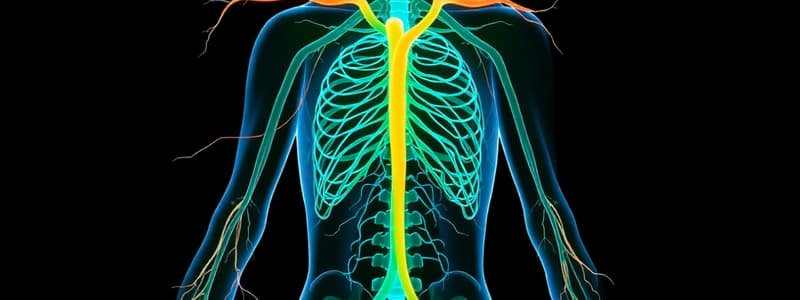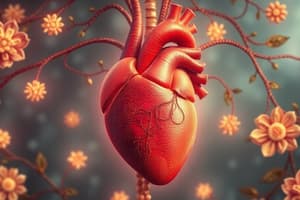Podcast
Questions and Answers
What is one method endotherms use to maintain their body temperature?
What is one method endotherms use to maintain their body temperature?
- Migration
- Hibernation
- Shivering (correct)
- Camouflage
Which of the following is a behavioral adaptation some animals use for temperature regulation?
Which of the following is a behavioral adaptation some animals use for temperature regulation?
- Changing fur color
- Huddling together (correct)
- Secreting mucus
- Eating more food
What physiological change do some animals make to control their body temperature effectively?
What physiological change do some animals make to control their body temperature effectively?
- Altering their bone structure
- Shrinking and expanding blood vessels (correct)
- Increasing their metabolic rate
- Changing their color
Which approach is NOT typically used by animals for temperature regulation?
Which approach is NOT typically used by animals for temperature regulation?
What are endotherms primarily able to do that ectotherms cannot regarding temperature management?
What are endotherms primarily able to do that ectotherms cannot regarding temperature management?
What is the primary function of the endocrine system?
What is the primary function of the endocrine system?
Which gland is responsible for hormonal regulation and also acts in the brain?
Which gland is responsible for hormonal regulation and also acts in the brain?
What dual role does the pancreas serve within the body?
What dual role does the pancreas serve within the body?
Which of the following glands is NOT part of the endocrine system?
Which of the following glands is NOT part of the endocrine system?
Which gland is primarily involved in calcium regulation in the body?
Which gland is primarily involved in calcium regulation in the body?
Which of the following glands is located in the brain?
Which of the following glands is located in the brain?
What is the function of the adrenal glands?
What is the function of the adrenal glands?
Which hormone-producing glands are located in the reproductive system?
Which hormone-producing glands are located in the reproductive system?
What role does the respiratory system play in blood gas exchange?
What role does the respiratory system play in blood gas exchange?
What is the primary function of the nervous system?
What is the primary function of the nervous system?
Which statement accurately describes the central nervous system (CNS)?
Which statement accurately describes the central nervous system (CNS)?
What functions are influenced by the hormones produced by the endocrine system?
What functions are influenced by the hormones produced by the endocrine system?
What distinguishes the peripheral nervous system (PNS) from the central nervous system (CNS)?
What distinguishes the peripheral nervous system (PNS) from the central nervous system (CNS)?
What is a major function of the hormones released by the endocrine system?
What is a major function of the hormones released by the endocrine system?
Which of the following is NOT a part of the central nervous system?
Which of the following is NOT a part of the central nervous system?
What aspect of body function does the nervous system primarily regulate?
What aspect of body function does the nervous system primarily regulate?
What is defined as any organism that can produce and create a disease?
What is defined as any organism that can produce and create a disease?
Which of the following is NOT a way that pathogens can enter the body?
Which of the following is NOT a way that pathogens can enter the body?
What is considered the first line of defense against pathogens?
What is considered the first line of defense against pathogens?
Which of the following is an example of a general response to infection?
Which of the following is an example of a general response to infection?
What is the role of B cells in the body's defense mechanisms?
What is the role of B cells in the body's defense mechanisms?
Which line of defense is characterized by a specific immune response?
Which line of defense is characterized by a specific immune response?
What can result from a general response to a pathogen?
What can result from a general response to a pathogen?
Which of the following is NOT part of the body's first line of defense?
Which of the following is NOT part of the body's first line of defense?
What is the main purpose of the cardiovascular system?
What is the main purpose of the cardiovascular system?
Which of the following is NOT a part of the circulatory system?
Which of the following is NOT a part of the circulatory system?
How does the heart function in the body?
How does the heart function in the body?
What are the four chambers of the heart?
What are the four chambers of the heart?
Which part of the heart pumps deoxygenated blood to the lungs?
Which part of the heart pumps deoxygenated blood to the lungs?
What type of blood vessels carry blood away from the heart?
What type of blood vessels carry blood away from the heart?
What role do capillaries play in the circulatory system?
What role do capillaries play in the circulatory system?
Which structure is responsible for separating oxygenated and deoxygenated blood in the heart?
Which structure is responsible for separating oxygenated and deoxygenated blood in the heart?
Study Notes
Circulatory System
- Delivers oxygen, hormones, nutrients, and other important substances to cells and organs
- Composed of heart, veins, arteries, and capillaries
- The heart pumps blood throughout the body to provide cells with oxygen for cellular respiration
Heart Function
- The heart has four chambers: right and left atrium, right and left ventricle
- Right ventricle pumps deoxygenated blood to the lungs through the pulmonary artery to get oxygenated blood
- Removes carbon dioxide from red blood cells and provides oxygen in return
Nervous System
- Sends messages from various parts of the body to the brain and back to the body
- Directs body actions
Central Nervous System (CNS)
- Brain and spinal cord
Peripheral Nervous System (PNS)
- All other parts of the nervous system
Endocrine System
- Releases hormones that control important body functions, such as growth and development, metabolism, and reproduction
- Major glands: hypothalamus, pancreas, pituitary gland, thyroid gland, parathyroid glands, adrenal glands, pineal body, ovaries, and testes
Immune System
- Defends the body against pathogens
- Pathogens enter the body through the mouth, eyes, nose, wounds, or bites
- First line of defense: skin, tears, mucus
- Second line of defense: general response to infection (fever, coughing, inflammation, phagocytosis)
- Third line of defense: immunity against specific pathogens (b cells attaching antibodies to pathogens and reproducing to kill them)
Thermoregulation
- Maintains body temperature
- Mechanisms: shivering, sweating, seeking sun or shade, shrinking and expanding blood vessels, huddling together, wearing clothing
Science Inquiry Skills
- Independent Variable: The factor that is changed
- Dependent Variable: The factor that is measured
- Controlled Variable: The factor that is kept the same
Studying That Suits You
Use AI to generate personalized quizzes and flashcards to suit your learning preferences.
Related Documents
Description
This quiz covers the essential functions and components of the human circulatory and nervous systems. Learn about how the heart operates, the role of blood in oxygen delivery, and how the nervous system communicates with the body. Test your knowledge on the endocrine system and its hormonal functions.




